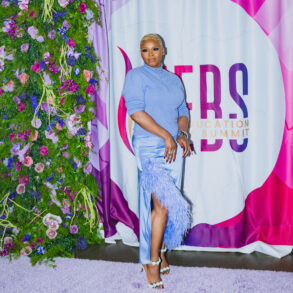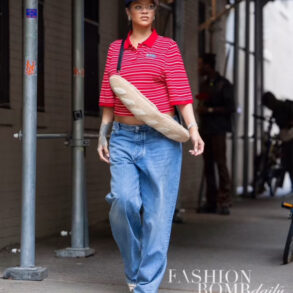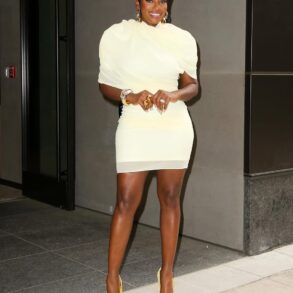This past August, Epperson Studio got a fortunate break in the business.
The collection, created by the fashion designer known as Epperson, moved into a modest, 650-square-foot space — a temporary one — just off Madison Avenue at 40 East 58th Street. It’s within steps of major international brands including Balenciaga, Fendi, Celine and Givenchy. So for a brief period at least, Epperson has a home for his collection in a high-rent district, providing the kind of exposure for his collection and accessories to the affluent crowd frequenting the area that he would not otherwise have. In its rather tight quarters, Epperson Studio doubles as a workspace for Epperson and a boutique for selling his fashion designs.
The kicker is, Epperson has the space rent-free.
“I have three months guaranteed here, and then it’s a month-to-month situation. If the landlord determines that someone wants to rent the space for the price they’re being offered, it will get rented.”
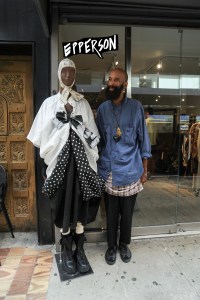
Epperson at his 58th Street shop.
Photo by Thomas Iannaccone.
Epperson’s situation would not have been possible without the support of an organization called Chashama, founded in 1995 by Anita Durst. She’s a member of the family behind The Durst Organization, which develops, builds, owns and manage office towers and residential buildings.
Chashama is as important as it has ever been, given how the pandemic left a landscape of vacated retail and office space. Chashama partners with property owners to provide unused space to designers, dancers, painters, performers and small businesses of varying types, free of charge, and has several New York State, New York City, business and private institutions as funders.
“We’ve helped hundreds of artists and designers move from working in their living rooms to a storefront, for a period that could be anywhere from a few months to a few years,” Durst said. Chashama, which means ‘to have vision’ in Farsi, provides space for creative individuals to create, rehearse, and show their work properly.
Currently, Durst said, “We have 45 locations spread across the five boroughs of New York City as well as in New Jersey, and in upstate New York in Rochester, Syracuse and Niagara.”
Durst, a native New Yorker and long a patron of avant-garde performing arts and the emerging arts scene in New York City, started Chashama following the death of her mentor, Iranian-born experimental director and playwright Reza Abdoh. She performed and worked in his company, Dar A Luz, but while Abdoh was alive and she was 19 years old, Durst started her mission to find spaces for artists to “connect real estate to art,” she said.
The lack of affordable space she felt was the biggest threat to a diverse cultural environment in New York City. Initially, she located seven spaces in midtown Manhattan where property owners were willing to donate temporarily. Through its nearly three-decade history, Chashama has secured more than 1 million square feet of space in New York City alone, for about 30,000 artists at different times. In addition, the organization has hosted approximately 4,000 public art events, and 1,500 classes in under-served communities. During the pandemic, the organization stepped up its interest in supporting small businesses, including minority and women-owned companies.
“The application process is really simple. It’s online,” Durst said. “Basically, we connect a small business or the artist with the right space, like a broker.”
Aside from Epperson, Chashama has found space for other designers, including Parron Allen, who was at 320 West 23rd Street from December through August. Designer Edwin Reyes had a temporary space at 1155 Sixth Avenue from Feb. 11 to March this year.
Art to Ware, a Black-owned and women-run small business founded by Lesley Ware for socially conscious, upcycled and locally made wearable art and gifts, currently has two locations, in the Westfield World Trade Center Oculus in lower Manhattan, and in the Port Authority Bus Terminal in Midtown.
Ooh Baby, established in 2018 by Brooklyn-based fashion designer Anika Ignozzi, was set up with a boutique space at 21 Greenwich Avenue in Manhattan. She creates upcycled, eco-conscious clothing, working hard at repairing and resewing clothes and sneakers, and painting over them. “She has a great following,” said Durst.
Asked what the criteria is for accepting a small business, designer or artist to the program, Durst replied, “We look for those who are responsible, who have a good business model, a little bit of a budget, and have a vision about community orientation.
“We provide a place where you can make mistakes,” Durst added. “We allow them the chance to grow, to show your strength, to express your vision,” Durst said. For those showing at such a high-profile site as the Oculus, there less room for mistakes, Durst suggested. But otherwise, “It’s really important to me to allow people to make mistakes.”
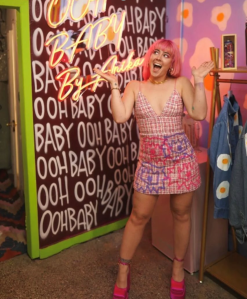
Anika Ignozzi of Ooh Baby.
In the ’80s, Epperson dressed windows at the former Charivari store, which was known for introducing avant-garde and emerging designers to the U.S. Around that time, he started designing fashion, and some of his styles can be found in the Chashama space in the Oculus alongside styles from other designers, as well as at his 58th Street shop. He once had stores on Brooklyn’s Fulton Street, and on Thompson and Grand streets in lower Manhattan. They’re both gone.
Epperson characterized his collection as multicultural with pieces that are flowing, voluminous, designed for comfort, and with an overall ethereal feeling. “I’m used to being compared to what you see in ‘Mad Max,’ ‘Star Wars’ and ‘Dune,’” Epperson said.
His collection features loose tunics, oversized dresses that billow out, a variety of lengths and jackets can that worn eight different ways. “If you flip them upside down they become like a kimono. If you put it over your head, it’s like a poncho, and if you put one foot in, wrap it around your waist, they are pants. My clothing is very versatile. It doesn’t go out of style because it’s not in style. The pieces are classics. I never follow a trend.”
His inspiration, he said, comes from “children, music, videos, a homeless person, life itself. Everything we are going through now sort of mixes in my work.”
He’s also inspired by what transpires inside his 58th Street shop. “When people walk in I introduce myself and take them back to show them the area where I work,” said Epperson. “And so then they’ve made a connection to the designer.”
This post was originally published on this site be sure to check out more of their content.





